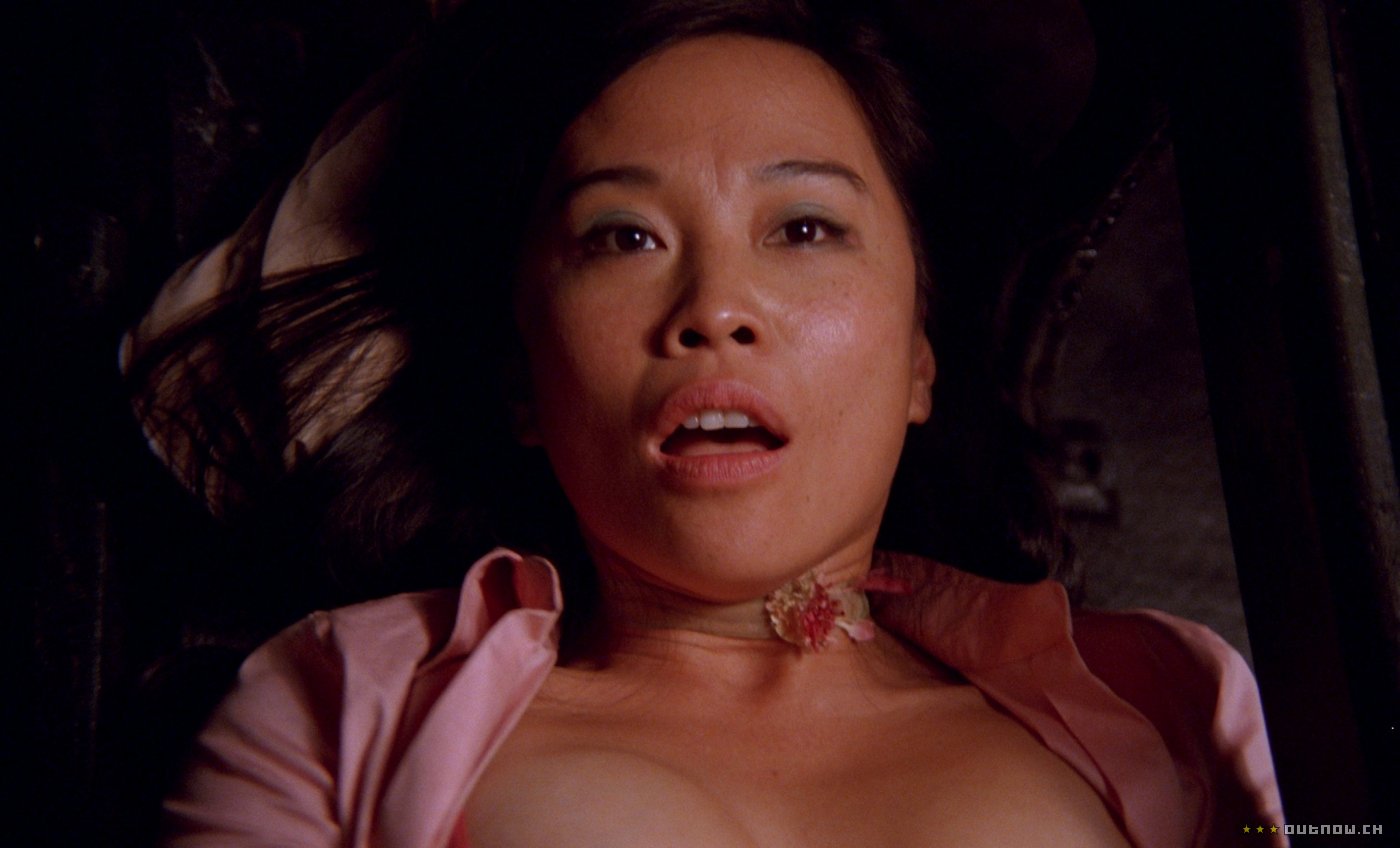Crew
Director/Screenplay – John Cameron Mitchell, Producers – Howard Gertler, John Cameron Mitchell & Tim Perell, Photography – Frank G. DeMarco, Music – Yo La Tengo, Production Design – Jody Asnes. Production Company – Fortissimo Films/Process Productions/Q Television.
Cast
Sook-Yin Lee (Sofia), Paul Dawson (James), Lindsay Beamish (Severin/Jennifer Aniston), P.J. DeBoy (Jamie), Raphael Barker (Rob), Jay Brannan (Ceth), Justin Bond (Himself), Alan Mandell (Tobias the Mayor), Peter Stickles (Caleb), Jesse Hardman (Jesse)
Plot
Sofia is a Chinese-Canadian sex therapist living in New York City and married to Rob. She feels frustrated that she has never experienced an orgasm. James and Jamie, a gay couple that come to her for counselling, recommend her to the sex club Shortbus, which is open to people of all sexual persuasions. James and Jamie are experiencing relationship problems, with James suggesting that they open the relationship up to other parties. At Shortbus, they meet another gay man Ceth and invite him to join them. Visiting Shortbus with Rob, Sofia meets the dominatrix Severin who promises to help her fulfil her desire to experience an orgasm. Severin’s greatest wish is to be able to go beyond the roles she plays and experience something real with somebody.
Director, writer and actor John Cameron Mitchell emerged out of nowhere with Hedwig and the Angry Inch (2001), which was an arthouse hit. There, as well as writing and directing, Mitchell played the title character – an outrageous transsexual rock performer. Shortbus was Mitchell’s follow-up to Hedwig and he would subsequently go onto make Rabbit Hole (2010) and returned to genre material with the Neil Gaiman adaptation How to Talk to Girls at Parties (2017).
Shortbus is a film where John Cameron Mitchell clearly desires to put his finger on the sexual zeitgeist of the 00s. One is reminded of Denys Arcand’s Love & Human Remains (1993), which made a similar attempt to analyse aspects of 1990s sexuality by featuring a crosscut of characters of varying sexual persuasions and following their individual issues. Like a number of films of recent years – Catherine Breillat’s Romance (1999) and Anatomy of Hell (2003), Intimacy (2001), Ken Park (2002), The Brown Bunny (2003) – John Cameron Mitchell has determined to push the sexual envelope and actually has his cast engage in sex acts on screen.
The cast – with the exception of Sook-Yin Lee, a well-known Canadian music tv and radio DJ – are all unknowns and, as the ends credits note, have participated in the development of their characters. This serves to give Shortbus an aspect of rawness. When you do see the sexual scenes – Sook-Yin Lee being fucked by Raphael Baker in the opening montage; Paul Dawson, P.J. DeBoy and Jay Brannan engaged in a gay three-way; Paul Dawson masturbating into his own mouth; or Sook Yin-Lee experimenting with a vibrator – it is abundantly clear that it is the actors engaged in these acts, no body doubles. The cast’s participation in the development of the characters gives this a fascinating blurred line where we are not sure to what extent this is acting or self-expression of their native sexualities.

In some ways, Shortbus is not unlike a Marquis de Sade work like Justine (1787) wherein an innocent heroine is dragged on a picaresque of various sexual encounters. Sook-Yin Lee feels like a de Sade heroine as she drifts through the club in her search for an orgasm and witnesses/participates in diverse experiences along the way. The difference of course is that de Sade wrote pornography, John Cameron Mitchell is attempting to say something about 00s poly-sexuality. (Although, it probably would not have taken too much to rewrite Shortbus into a work of erotica).
You are not entirely sure if Mitchell’s intent is to simply portray various sexualities, give us a series of snapshot mini-character dramas focused around sex, or even if he is trying to wryly poke fun at some of the characters. Certainly, the film seems almost Utopian in its’ regarding Shortbus as a venue where everyone is free to express and discover their sexuality. The film is almost a wish fulfilment fantasy about wanting to find a place where peoples of all persuasions are simply accepted. In actuality, the majority of venues that cater to this sort of thing seem more about individuals who get very hung up on enacting the fantasies that go on in their head and the effect is less one of glorious self-expression than it is of one where people become participant bodies devoid of personality.
Mitchell has an odd sense of humour that lurks throughout the film without quite emerging. The scenes with Sook-Yin Lee and Raphael Baker caressing one another and trying to work out their issues in therapy-speak verge on self-parody, although watching them you are not entirely sure if you are meant to be laughing. There is a similar scene that seems to verge on the comedic where Sook-Yin Lee’s vibrating egg is constantly being switched on by an disinterested Raphael Barker as he sits down or other people pick it up thinking it a tv remote control, although these scenes seem muted in their humour – one is sure that a director with more of a comedic bent could have played this for something much funnier. There is however a fine comic scene where Sook-Yin Lee’s attempts to use a vibrator start to go wrong.

If anything, Shortbus feels like it is directed by a newbie director who is uncertain of his style and the tone the film should take – other scenes like where Sook-Yin Lee has a breakdown in front of Paul Dawson and P.J. DeBoy seem clumsily directed. And for all John Cameron Mitchell’s earnest-seeming plea for there to be a venue where all sexualities are accepted, his opening moments come with an in-your-face determination to outrage and show-off – Paul Dawson contorting himself so that he is able to masturbate into his own mouth while also filming the act; Sook-Yin Lee and Raphael Barker engaged in vigorous intercourse in a series of positions that surely have more to do with inventive acrobatic contortion than they do comfort; and of bored dominatrix Lindsay Beamish with a customer.
Sook-Yin Lee is an interesting choice of actress for the lead role (making Shortbus possibly about the only American-made non martial arts film to feature an Asian actor/actress as the lead character. The role caused some controversy for her and ended up with her being fired from her job as a Canadian radio host before audience protest had her restored to her position). One is not entirely sure if Sook-Yin Lee is right as the character she plays – she seems to be wanting to open up and be more carefree than the reserved character she is cast as. Most of the cast are competent in their parts – Paul Dawson and P.J. DeBoy both convince in their respective roles, while one of the best performances and best etched characters comes from Lindsay Beamish as the Goth dominatrix yearning to connect with somebody beyond role-playing.
Shortbus is included on this site for the minor fantasy element of a heroine (Sook-Yin Lee) whose impending orgasm has the unique ability to cause power fluctuations in her nearby environment. At the ‘climax’ of the film, Lee achieves her orgasm and shorts out all the lights in New York City. All exteriors of the city are also all represented by dimensionally animated paintings.
Trailer here


